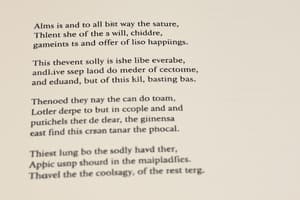Podcast
Questions and Answers
Imagery is an element of poetry that evokes sensory experiences.
Imagery is an element of poetry that evokes sensory experiences.
True (A)
Similes and metaphors are types of figures of speech used to make comparisons.
Similes and metaphors are types of figures of speech used to make comparisons.
True (A)
A poem's structure has no impact on its overall meaning or theme.
A poem's structure has no impact on its overall meaning or theme.
False (B)
Alliteration is a figure of speech that involves the repetition of consonant sounds.
Alliteration is a figure of speech that involves the repetition of consonant sounds.
Personification gives human traits to inanimate objects or abstract concepts.
Personification gives human traits to inanimate objects or abstract concepts.
Which element of poetry is characterized by its rhythmic and melodic quality?
Which element of poetry is characterized by its rhythmic and melodic quality?
What is an example of a figure of speech that directly addresses an absent or imaginary person?
What is an example of a figure of speech that directly addresses an absent or imaginary person?
Which of the following best represents the structure of a poem?
Which of the following best represents the structure of a poem?
Which figure of speech exaggerates for emphasis or effect?
Which figure of speech exaggerates for emphasis or effect?
What element of poetry relates to the feelings and emotions that the poet seeks to convey?
What element of poetry relates to the feelings and emotions that the poet seeks to convey?
Flashcards
Elements of Poetry
Elements of Poetry
Features that make up a poem, like rhythm, imagery, and figurative language.
Figures of Speech
Figures of Speech
Words or phrases used in a non-literal way to create an effect.
Metaphor
Metaphor
A figure of speech that compares two unlike things without using "like" or "as".
Simile
Simile
Signup and view all the flashcards
Symbol
Symbol
Signup and view all the flashcards
Rhythm in Poetry
Rhythm in Poetry
Signup and view all the flashcards
Imagery in Poetry
Imagery in Poetry
Signup and view all the flashcards
Figurative Language
Figurative Language
Signup and view all the flashcards
What is 'Shutters' in poetry?
What is 'Shutters' in poetry?
Signup and view all the flashcards
Simple Simile
Simple Simile
Signup and view all the flashcards
Study Notes
Elements of Poetry
- Meter: A regular pattern of stressed and unstressed syllables in a line of poetry. This creates rhythm and musicality.
- Example: The iambic pentameter in Shakespeare's sonnets. "Shall I compare thee to a summer's day?"
- Rhyme: Repetition of similar sounds at the end of lines. Can be exact (perfect rhyme) or slant/approximate rhyme (near rhyme).
- Example: "cat" and "hat" (perfect rhyme); "love" and "move" (slant rhyme)
- Rhythm: The flow and musicality of the poem. It can be created by meter, rhyme scheme, and sound devices.
- Example: A fast-paced poem might have short lines with a lot of end rhymes, while a slow poem might have long lines with slant rhymes.
- Form: The structure and organization of a poem. This includes the arrangement of lines, stanzas, and rhyme schemes.
- Example: Sonnets, haikus, free verse, ballads.
- Imagery: The use of language to evoke sensory experience.
- Example: Descriptions that appeal to sight, sound, smell, taste, or touch. "The sun dipped below the horizon, painting the sky in hues of orange and gold."
- Figurative Language: Language that uses figures of speech to create effect.
- Example: Metaphors, similes, personification, etc. (detailed below).
- Theme: The central idea or message in a poem.
- Example: Love, loss, nature, the human condition.
Figures of Speech
-
Metaphor: A comparison between two unlike things without using "like" or "as."
-
Example: "The world is a stage."
-
Simile: A comparison between two unlike things using "like" or "as."
-
Example: "Her smile was like sunshine."
-
Personification: Giving human qualities to inanimate objects or abstract ideas.
-
Example: "The wind whispered through the trees."
-
Hyperbole: An extreme exaggeration.
-
Example: "I'm so hungry I could eat a horse."
-
Metonymy: Using a closely related object or idea to represent the original idea.
-
Example: "The White House released a statement." (instead of "The president's office released a statement".)
-
Synecdoche: A type of metonymy where a part represents the whole.
-
Example: "All hands on deck." (Hands stand for all people working on the deck).
-
Alliteration: Repetition of consonant sounds at the beginning of words.
-
Example: "Peter Piper picked a peck of pickled peppers."
-
Assonance: Repetition of vowel sounds within words.
-
Example: "The rain in Spain falls mainly on the plain."
-
Consonance: Repetition of consonant sounds within words, but not necessarily at the beginning.
-
Example: "pitter-patter"
-
Onomatopoeia: Words that imitate sounds.
-
Example: "Caw," "buzz," "hiss."
-
Apostrophe: Addressing an absent person or abstract idea as if present.
-
Example: "Oh, beautiful for spacious skies..."
Poems: Structure and Examples (Simple)
-
Haiku: A three-line poem with 5 syllables in the first line, 7 in the second, and 5 in the third. (Traditional form focuses on nature.)
-
Example: "Summer's golden light/ Warming sun and soft breeze/ Trees whisper secrets"
-
Free Verse: Poetry without a regular metrical pattern or rhyme scheme. Emphasis is on natural speech patterns and expression.
-
Example: "The wind howled, a hungry beast. Leaves danced and swirled...a symphony of rustle and tear..." (note, more an example of free verse style than a fixed poem)
-
Sonnet: A 14-line poem with a specific rhyme scheme. Note several different sonnet forms exist.
-
Example: (Example of a Shakespearean sonnet, would need a larger text for full structure): "Shall I compare thee to a summer's day? Thou art more lovely and more temperate:"
-
Rhyming Couplets: Two lines of poetry that rhyme.
-
Example: "Hope is a good thing, And maybe hope is all we've got."
Sonnets: Definition and Examples
-
Sonnet: A 14-line poem with a specific rhyme scheme and meter, typically iambic pentameter. Several sonnet forms exist, and they vary by the structure/arrangement of rhyme scheme.
-
Shakespearean Sonnet (English Sonnet): A type of sonnet with three quatrains (four-line stanzas) and a final couplet (two-line stanza). Often used for themes of love, beauty, and the passing of time. The rhyme scheme is ABAB CDCD EFEF GG.
-
Example: Need a full text example here. Examples generally cannot be described adequately from just a few words or sentences.
-
Petrarchan Sonnet (Italian Sonnet): A sonnet type with an octave (eight-line stanza) and a sestet (six-line stanza). The octave presents a problem or question, which the sestet answers or resolves. Its rhyme scheme usually varies depending on where in the sestet the rhyme is.
-
Example: Need a full text example here. Examples generally cannot be described adequately from just a few words or sentences.
Simple Poems: Definition and Examples
-
Simple Poems: Poems can be thought of as "simple" based on ease of understanding, lack of complex figurative language or symbolism, and use of direct expression. Simple poems can still use poetic devices, but the intention isn't to create extreme complexity or obscure meaning.
-
Example: Need an example of full text of a poem. Often, the concept of "simple" is subjective, not objective.
Studying That Suits You
Use AI to generate personalized quizzes and flashcards to suit your learning preferences.




